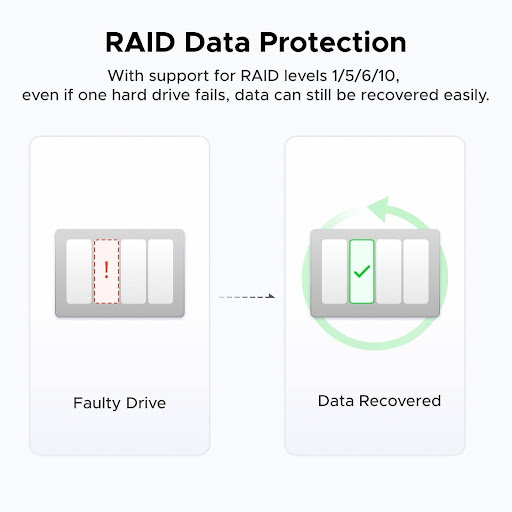
In the quest for the perfect creative workspace, nothing disrupts concentration and recording quality quite like the persistent hum of storage equipment. Media professionals face a unique challenge: the need for massive storage capacity that doesn’t compromise their acoustic environment. Whether recording voiceovers, mixing audio, or maintaining focus during marathon editing sessions, traditional storage solutions often introduce unwanted noise that can contaminate recordings and break creative flow.
Enter the silent 4bay NAS (Network Attached Storage) solution – a sophisticated answer to this dual requirement. These specialized systems offer the perfect balance between substantial storage capacity and whisper-quiet operation. With the potential to house up to 136TB of data while maintaining near-silent operation, these systems represent the ideal compromise between performance and acoustic consideration.
For media professionals seeking to optimize their workspace, silent 4-bay NAS solutions offer a compelling combination of robust storage architecture and acoustic engineering that keeps noise levels at a minimum while ensuring your creative assets remain secure and accessible.
Why Media Professionals Need Specialized 4bay NAS Systems
The exponential growth in media resolution demands has transformed storage requirements for creative professionals. With 4K footage consuming approximately 350GB per hour and 8K projects requiring up to 1.4TB hourly, traditional storage solutions simply can’t keep pace. Project archives that once fit comfortably on external drives now demand enterprise-level capacity, making specialized storage solutions not just a luxury, but a necessity.
The acoustic environment presents an equally critical challenge. During voiceover sessions or podcast recordings, even minimal background noise can render takes unusable. Traditional servers, with their constant fan noise and drive vibrations, introduce unwanted acoustic artifacts that can bleed into sensitive microphones. Similarly, during intensive editing sessions that stretch for hours, the persistent hum of conventional storage systems creates mental fatigue that impacts creative decision-making.

While cloud storage offers unlimited capacity, its practical limitations become apparent in media workflows. Real-time 4K editing requires consistent, high-speed access that cloud solutions can’t guarantee. Additionally, monthly costs for cloud storage at media-production scale quickly exceed the investment in a dedicated 4-bay NAS. These systems provide the perfect middle ground – offering local, high-speed access to massive storage capacity while maintaining the whisper-quiet operation essential for creative environments.
Essential Features of Silent 4-Bay NAS Solutions
Effective Heat Dissipation Without Noise Pollution
Modern silent NAS solutions employ sophisticated thermal management techniques that prioritize noise reduction without compromising cooling efficiency. Advanced fanless designs utilize strategically placed heatsinks and natural convection pathways to dissipate heat effectively. When fans are necessary, acoustic-optimized cooling systems incorporate variable-speed motors and fluid-dynamic bearings that operate below 20 decibels – quieter than a whisper.
The enclosure design plays a crucial role in noise reduction, featuring vibration-dampening materials and specialized drive trays with rubber isolation mounts. These components work together to absorb mechanical resonance from hard drives, preventing it from amplifying through the chassis. Premium models like UGREEN’s silent NAS solutions utilize aluminum-magnesium alloy construction that efficiently conducts heat while maintaining structural integrity for optimal acoustic performance.
NAS Multitasking Capabilities for Creative Workflows
Silent 4-bay NAS systems excel at handling multiple simultaneous tasks without increasing noise output. Modern units support concurrent 4K video editing streams while managing background processes like automated backups and media indexing. Hardware transcoding capabilities, powered by dedicated chips, enable real-time format conversion without taxing the main processor, maintaining consistent performance levels during intensive operations.
To support these demanding workflows, current-generation systems feature a minimum 4GB RAM configuration, expandable to 32GB for complex media operations. Quad-core processors with media-optimized instruction sets handle multiple editing sessions while maintaining thermal efficiency. Advanced caching algorithms optimize frequently accessed assets, reducing drive activity and associated noise while improving overall system responsiveness in collaborative environments.
Maximizing Your 136TB Storage Potential
Effective storage management begins with understanding drive configuration options for your 4-bay NAS. While raw capacity calculations might suggest 72TB using 18TB drives, actual usable space varies significantly based on RAID configuration. Modern RAID calculator helps determine the exact capacity while balancing data protection needs. For instance, RAID 5 sacrifices one drive’s worth of storage for parity, providing excellent performance and single-drive failure protection – ideal for most media workflows.
RAID 6 offers enhanced security through dual parity, protecting against two simultaneous drive failures at the cost of additional storage overhead. This configuration proves particularly valuable for irreplaceable project files and final deliverables. Hybrid solutions, combining different RAID levels across storage pools, allow professionals to match protection levels to asset importance. Critical project files might utilize RAID 6, while work-in-progress renders operate in RAID 5 for optimal performance.
Integration with creative suites demands strategic backup planning. Implementing automated incremental backups during off-hours maintains data security without impacting active workflows. Synchronizing project files across storage pools ensures redundancy while keeping frequently accessed assets on faster RAID configurations. This tiered approach maximizes both storage efficiency and data protection.
Implementing Quiet Operation in Studio Environments
Understanding decibel ratings is crucial for maintaining pristine recording environments. Silent NAS solutions typically operate below 20dB, comparable to rustling leaves, while standard NAS systems can exceed 30dB. This difference becomes critical during sensitive recording sessions where every background noise matters. For perspective, professional recording studios maintain ambient noise levels below 25dB, making truly silent storage solutions essential for maintaining recording integrity.
Strategic placement dramatically impacts acoustic performance. Mounting NAS units on isolation platforms using rubber or neoprene feet reduces vibration transfer to surfaces. Purpose-built acoustic cabinets with proper ventilation provide additional noise reduction while ensuring adequate airflow. For maximum isolation, consider placing the NAS in an adjacent room, using extended USB or Thunderbolt connections to maintain direct-attached storage performance while eliminating acoustic interference entirely.
Modern NAS systems offer customizable firmware profiles that balance performance and acoustic output. Activating quiet operation modes during recording sessions reduces drive spin speeds and adjusts cooling algorithms to prioritize silence over maximum performance. These profiles can be scheduled to automatically engage during known recording hours, reverting to standard operation for intensive tasks like overnight renders.
Step-by-Step: Building Your Silent Media Storage Solution
Hardware Selection Guide
When selecting a silent 4-bay NAS solution, focus on models featuring advanced acoustic engineering. Look for units with aluminum chassis construction and integrated sound-dampening materials. The most effective silent NAS designs incorporate passive cooling elements with minimal fan usage. Essential features include vibration-reducing drive mounts, fluid dynamic bearing fans, and customizable cooling profiles that prioritize quiet operation while maintaining thermal stability.
For drive selection, helium-filled hard drives offer superior acoustic performance compared to traditional air-filled models. These drives operate with significantly reduced turbulence and vibration, resulting in lower noise emissions. Enterprise-grade NAS drives with advanced firmware features allow customized spin-down timing and acoustic management settings, further reducing operational noise without compromising reliability.
Configuration Best Practices
Begin your silent NAS setup by activating built-in quiet operation modes through the system firmware. Configure variable fan speed thresholds to favor gradual ramping rather than sudden changes that could create noticeable sound variations. Implement drive spin-down policies during periods of inactivity, particularly for drives containing archived content that doesn’t require immediate access.
Automate media workflows to operate during off-hours when acoustic considerations are less critical. Schedule intensive tasks like backups and media indexing for overnight processing. Utilize built-in transcoding features to create proxy files automatically, reducing the need for constant high-performance drive access during editing sessions. Configure storage pools with frequently accessed content on the most acoustically optimized drives, while reserving noisier drives for deep archive storage.
Future-Proofing Your Creative Workspace
The convergence of silent operation and massive storage capacity in modern 4bay NAS solutions represents a breakthrough for media professionals seeking to optimize their creative environments. These systems effectively eliminate the traditional compromise between storage capabilities and acoustic interference, enabling pristine recording conditions while maintaining immediate access to extensive media libraries. By implementing proper acoustic management techniques and leveraging advanced cooling technologies, creative professionals can now maintain a noise floor below 20dB while managing hundreds of terabytes of data.
As media resolutions continue to increase and workflow demands expand, the scalability of 4bay NAS solutions ensures long-term viability for growing studios. Whether upgrading individual drives or implementing advanced RAID configurations, these systems adapt to evolving storage requirements while maintaining their crucial silent operation. For videographers working with 8K footage, audio engineers recording sensitive acoustic performances, or content creators managing extensive media libraries, silent 4bay NAS solutions provide the ideal foundation for future-proof creative workflows.
Take a moment to evaluate your current storage infrastructure’s impact on your creative environment. Consider how ambient noise affects your recording quality and concentration during critical editing sessions. A silent 4-bay NAS solution might be the missing piece in elevating your studio’s professional capabilities while ensuring your creative space remains acoustically pristine.






